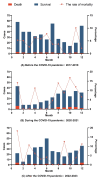Epidemiology and Mortality Risk of Severe Viral Pneumonia During the Pre-Pandemic, COVID-19 Pandemic and Post-Pandemic Era: A Retrospective Study of Hospitalized Children in ShenZhen, China Between 2017 and 2023
- PMID: 40178724
- PMCID: PMC11968590
- DOI: 10.1007/s44197-025-00398-7
Epidemiology and Mortality Risk of Severe Viral Pneumonia During the Pre-Pandemic, COVID-19 Pandemic and Post-Pandemic Era: A Retrospective Study of Hospitalized Children in ShenZhen, China Between 2017 and 2023
Abstract
Purpose: This study aims to investigate the spectrum of viruses leading to severe viral pneumonia (SVP) and the associated risk factors for mortality among pediatric patients in the pediatric intensive care unit (PICU).
Methods: Taking the outbreak and end of the COVID-19 pandemic as a aboundary, The pre-pandemic period of COVID-19 spans from 01/2017 to 12/2019, the pandemic period from 01/2020 to 12/2021, and the post-pandemic period from 01/2022 to 12/2023. Patients were subsequently stratified into survivor and non-survivor groups based on clinical outcomes.
Results: A total of 1007 patients (median age 1.42 years, range 0.58-4.00; male: female ratio 1.7:1) diagnosed with SVP. Cases were stratified into pre-pandemic (n = 419, 41.6%), pandemic (n = 272, 27.0%), and post-pandemic (n = 316, 31.4%) periods. Viral predominance varied across phases: Pre-pandemic: Influenza A (IVA, 37.0% [155/419]), respiratory syncytial virus (RSV, 29.8%), adenovirus (19.8%), and influenza B (15.5%). Pandemic phase: Human rhinovirus (HRV, 40.1% [109/272]), RSV (33.1%), parainfluenza viruses (11.4%), and bocavirus (HBoV, 10.7%). Post-pandemic: HRV (24.4% [77/316]), RSV (22.8%), HBoV (14.2%), and IVA (13.6%). Comparative analysis revealed significant intergroup differences in the proportion of patients aged < 3 years, primary immunodeficiency disorders (PIDs), and sepsis between pure viral infection deaths and coinfection-associated fatalities among SVP cases. Logistic regression identified eight independent mortality predictors: acute leukemia, other malignant tumors, PIDs, moderate-to-severe underweight, rhabdomyolysis, acute respiratory distress syndrome (ARDS), infection-related encephalopathy, and multiorgan dysfunction syndrome (MODS). The prediction model demonstrated robust discriminative capacity for SVP mortality: sensitivity 73.8%, specificity 90.2%, and AUC 0.888 (95%CI 0.838-0.938) via ROC curve analysis.
Conclusions: The COVID-19 pandemic has altered the landscape of respiratory viruses causing SVP in children. The presence of underlying health conditions, particularly acute leukemia, other malignancies, and immunodeficiency, significantly increases the risk of death in children with viral pneumonia. The risk prediction model offers a reliable tool for clinical practice to predict mortality in these patients.
Keywords: Children; Epidemiological Trends; Risk Factors; Severe Pneumonia; Viral Etiologies.
© 2025. The Author(s).
Conflict of interest statement
Declarations. Ethics approval and consent to participate: This study was conducted in compliance with the protocol approved by the Ethics Committee of the Shenzhen Children’s Hospital ( Research approval number: 2022033). Conflict of interest: The authors report no conflicts of interest associated with this work.
Figures






Similar articles
-
[Clinical characteristics of hospitalized children with respiratory syncytial virus infection and risk prediction of severe illness during the post-COVID-19 era in Kunming].Zhonghua Er Ke Za Zhi. 2024 Mar 25;62(4):323-330. doi: 10.3760/cma.j.cn112140-20240219-00109. Zhonghua Er Ke Za Zhi. 2024. PMID: 38527502 Chinese.
-
Burden of viral respiratory infections in the pediatric intensive care unit: age, virus distribution, and the impact of the COVID-19 pandemic.Eur J Pediatr. 2024 Dec 18;184(1):88. doi: 10.1007/s00431-024-05914-8. Eur J Pediatr. 2024. PMID: 39692898
-
Impact of COVID-19 pandemic measures on hospitalizations and epidemiological patterns of twelve respiratory pathogens in children with acute respiratory infections in southern China.BMC Infect Dis. 2025 Jan 22;25(1):103. doi: 10.1186/s12879-025-10463-y. BMC Infect Dis. 2025. PMID: 39844061 Free PMC article.
-
Clinical and epidemiological characteristics of respiratory syncytial virus, SARS-CoV-2 and influenza paediatric viral respiratory infections in southwest Saudi Arabia.Ann Med. 2025 Dec;57(1):2445791. doi: 10.1080/07853890.2024.2445791. Epub 2024 Dec 24. Ann Med. 2025. PMID: 39717000 Free PMC article.
-
Impact of COVID‑19 pandemic restrictions and subsequent relaxation on the prevalence of respiratory virus hospitalizations in children.BMC Pediatr. 2024 Feb 2;24(1):91. doi: 10.1186/s12887-024-04566-9. BMC Pediatr. 2024. PMID: 38302912 Free PMC article. Review.
References
-
- Bradley JS, Byington CL, Shah SS, et al. The management of community-acquired pneumonia in infants and children older than 3 months of age: clinical practice guidelines by the pediatric infectious diseases society and the infectious diseases society of America. Clin Infect Dis. 2011;53(7):e25–76. - PMC - PubMed
-
- Katie M, Andrew B, Nelson A et al. Impact of viral respiratory pathogens on outcomes after pediatric cardiac surgery. Pediatr Crit Care Me 2017; 18(3). - PubMed
MeSH terms
LinkOut - more resources
Full Text Sources
Medical

